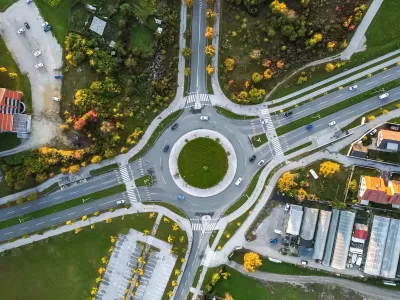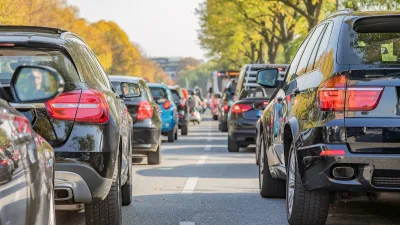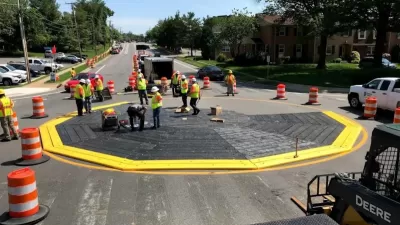What drives the U.S. backlash to roundabouts — objectively safer and more efficient than stop-and-go intersections?

Ah, the roundabout. A common sight in many global regions and a fearsome adversary for many American drivers.
But as the movement to install roundabouts and traffic circles — a type of intersection designed to keep traffic flowing, often without stoplights — John Surico wonders whether U.S. drivers can finally embrace the (incredibly efficient!) model. As Surico notes, “Nationwide, the US now has more than 10,000 roundabouts, a figure that’s doubled in a decade.”
In some U.S. communities where roundabouts have been installed, the backlash has been fierce. Yet “By just about all measures, the modern style of roundabout — where cars are meant to seamlessly yield in a circular pattern — are an easy win: They save lives, reduce traffic delays and cut emissions.”
Surico attributes the vitriolic opposition to roundabouts in part to a lack of familiarity and an image of roundabouts as only monstrous, multi-lane traffic circles. Cities that install more roundabouts at once tend to have more success as drivers learn to navigate them and become accustomed to them. In Carmel, Indiana, a bold experiment led by then-mayor Jim Brainard installed over 150 roundabouts across the city. Early opposition turned to strong support when residents began to notice the congestion relief and cost savings. The former mayor credits public outreach and education, which included informational TV spots and neighborhood meetings, with encouraging residents to understand and appreciate the benefits of roundabouts.
FULL STORY: Can American Drivers Learn to Love Roundabouts?

Montreal Mall to Become 6,000 Housing Units
Place Versailles will be transformed into a mixed-use complex over the next 25 years.

Planetizen Federal Action Tracker
A weekly monitor of how Trump’s orders and actions are impacting planners and planning in America.

DARTSpace Platform Streamlines Dallas TOD Application Process
The Dallas transit agency hopes a shorter permitting timeline will boost transit-oriented development around rail stations.

Trump's “Able Bodied” Public Housing Limits Could Displace Over 300,000 New Yorkers
As part of 43% cut to federal rental assistance, Trump is proposing a two-year limit on public housing tenure for “able bodied adults.”

Nine Ways to Use Curb Space That Aren’t Parking
California’s new daylighting law bans parking within 20 feet of crosswalks. How can cities best use this space?

ADUs for Sale? San Diego Could Legalize Backyard Condos
As one of 25 proposed amendments, San Diego may soon allow accessory dwelling units to be bought and sold as individual homes.
Urban Design for Planners 1: Software Tools
This six-course series explores essential urban design concepts using open source software and equips planners with the tools they need to participate fully in the urban design process.
Planning for Universal Design
Learn the tools for implementing Universal Design in planning regulations.
City of Mt Shasta
City of Camden Redevelopment Agency
City of Astoria
Transportation Research & Education Center (TREC) at Portland State University
City of Camden Redevelopment Agency
Municipality of Princeton (NJ)
Regional Transportation Commission of Southern Nevada





























